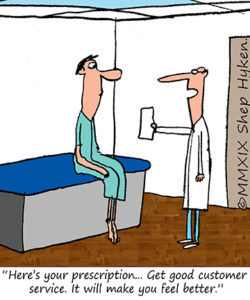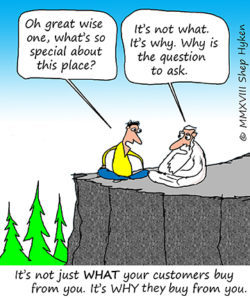Shep Hyken's Blog, page 134
January 7, 2019
5 Top Customer Service Articles for the Week of January 7, 2019
Each week I read a number of customer service and customer experience articles from various resources. Here are my top five picks from last week. I have added my comment about each article and would like to hear what you think too.
What’s in the box? Insights into the Subscription Based Economy by Sonakshi Nathak
(LinkedIn) Glancing over the New York Times app for your daily briefings as you brew your coffee, you head to the counter to discover a box from Blue Apron to prepare Mexican-Spiced Chicken before turning to Netflix to binge the latest season of Narcos. It’s become such a big part of your life that you fail to notice it anymore, but you’re now fully enmeshed in the subscription economy.
My Comment: I’ve been studying and writing a lot about the subscription model over the past year. For the company that figures it out, it positively impacts the bottom line, and just as important, positively impacts the customer’s experience. It’s convenient and predictable, and customers love it. If you haven’t explored the subscription model for your business, this article will give you a good introduction.
CEOs Who Are Transforming Customer Experience by Robert Reiss
(Forbes) It is no small wonder that other companies find themselves chasing the same goal, knowing that while they won’t be an Amazon, they might achieve and do the right thing and truly deliver for their customers, and as a result advance leadership in their industry.
My Comment: This article by Robert Reiss features ideas from an interview with three CEOs. I love this line from Jack Mitchell, chairman of Mitchell stores (recognized for their excellent customer service), that focuses on personalization: “Exceptional customer service boils down to knowing your customers–really knowing them–their names and nicknames, what they do, their cat’s name, whether they like baseball or field hockey or curling.”
Beyond Chatbots: How Artificial Intelligence Can Humanize the Customer Experience by Dan Gingiss
(MarTech Advisor) The rise of artificial intelligence has led many people to believe that machines will take over many of the job functions in the marketing industry. However, when it comes to customer experience, the best results will occur when machines and humans work together.
My Comment: Rather than AI replacing humans in the customer support and marketing worlds, what if it took on a support role. Dan Gingiss writes, “The rise of artificial intelligence has led many people to believe that machines will take over many of the job functions in the marketing industry. However, when it comes to customer experience, the best results will occur when machines and humans work together.”
Call center tips to ensure successful agents by Scott Sachs
(SearchCRM) Once hiring managers find the right people for the job, contact center agents need both proper training and office tools to be successful in their roles.
My Comment: Here are three tips for customer service agents, but they can also be applied to just about anyone who interacts with customers, as well as employees. Hire the right people, train them well and give them the tools they need to do a great job.
3 Tips To Create A Mission That Will Drive Growth by Kara Goldin
(Forbes) It’s not always easy to know what your ultimate goal should be. Here are three tips for uncovering the mission that will drive growth at your business.
My Comment: What drives growth in business? Start by making customers central to your mission. That’s the first of three strategies shared by entrepreneur Kara Goldin that can help any organization be more successful.
Shep Hyken is a customer service expert, professional speaker and New York Times bestselling business author. For information on The Customer Focus customer service training programs go to www.TheCustomerFocus.com. Follow on Twitter: @Hyken
customer service training programs go to www.TheCustomerFocus.com. Follow on Twitter: @Hyken

The post 5 Top Customer Service Articles for the Week of January 7, 2019 appeared first on Shep Hyken.
January 4, 2019
Guest Blog: How to Build a Comprehensive Onboarding Module for Customer Service Training
This week we feature an article by Anand Srinivasan who writes about how important it is to have a properly trained customer service team to ensure business success. – Shep Hyken
 Customer service is one of the primary drivers of growth in many organizations. Studies show that businesses that provide a positive experience to their buyers positively impact their profitability. For instance, a Dimension Data report found that nearly 84% of organizations that worked towards improving customer experience saw a corresponding increase in revenue.
Customer service is one of the primary drivers of growth in many organizations. Studies show that businesses that provide a positive experience to their buyers positively impact their profitability. For instance, a Dimension Data report found that nearly 84% of organizations that worked towards improving customer experience saw a corresponding increase in revenue.
In terms of sales, the probability of selling to an existing customer is up to 14 times higher than the odds of selling to a new customer. Repeat purchase is however driven by how happy the customer is after a transaction. Over 86% of customers are reported to be ready to pay more for a better experience.
In other words, the success of a business is directly impacted by how well the customer service team is trained. Building an effective onboarding module for your support team is thus critical to business growth.
Traits that define a great customer service rep
The first step in building an effective onboarding module is to identify the traits that define great customer service. There are a few factors that matter here. For one, a good customer service rep must be aware of their company’s missions and values. This also includes a good understanding of the business.
Secondly, there should be a balance between professionalism and personality when it comes to interacting with customers. It is easy for an individual representing a ‘fun’ brand to cross over from informal to unprofessional. It is critical for a service rep to be mindful of their tone and tenor at all times.
Listening is a vital aspect of great customer service. It is not always possible for a service rep to resolve an issue satisfactorily. Regardless of this, it is important to show your customers that they are valued and that their issues are being actively fixed or monitored.
Lastly, customer service reps are expected to manage their time effectively. A well-trained executive would know how to deal with customer issues promptly and also disengage them without making them feel unvalued or unheard.
Building an onboarding module
Customer service training is a continuous process and onboarding is merely the first step in the journey. The ideal onboarding module helps a new recruit get inducted into their team and continues to exist until the employee has fully eased into their role in the organization.
It is highly recommended for businesses to invest in eLearning tools for the onboarding process. Firstly, this ensures consistent training practices for all freshly recruited employees. More importantly, customer service reps are routinely hired from multiple time zones. LMS offers an effective platform to remotely train workers without the need for face-to-face interaction.
Modern trainers rely on techniques like byte-sized learning to improve learning retention. This strategy breaks down lessons into small chunks of not more than 3-10 minutes in length. Workers show greater engagement and retention using such techniques.
Such training methods must also be sufficiently complemented with goal-setting sessions. Clear goals over periods of 3 months, 6 months and a year should be set out for the new hire, along with performance objectives that are expected out of him or her.
In addition to this, management should hold an informal check up on the new hire once the employee has been around for 30 days. This helps the organization address any issues that are of immediate concern of the employee. Such periodic checks every two or three months help organizations assess the progress in learning and performance and are thus critical to both the worker and the business.
Finally, the onboarding process should be open to feedback in order to calibrate it and perfect it based on the concerns of the people who go through it. A good onboarding process should continuously iterate and improve based on constant feedback.
Customer service is no longer viewed as a cost-center. Businesses like Zappos have been able to successfully differentiate themselves on the basis of great customer service. Establishing a solid onboarding program for your service executives can thus play a pivotal role in the success of your organization.
Anand Srinivasan is the founder of Hubbion, a free-to-use project management tool for small and medium businesses. He is the author of How We Did It.
For more articles from Shep Hyken and his guest contributors go to customerserviceblog.com.
Read Shep’s latest Forbes article:
Happy New Year: It’s Time to ‘Start Over’

The post Guest Blog: How to Build a Comprehensive Onboarding Module for Customer Service Training appeared first on Shep Hyken.
January 2, 2019
A Doctor’s Prescription for Good Customer Service
 Here’s another great story we can learn from. This reminds us that having a good system with good people who understand how to take care of their customers is the backbone of a good service experience.
Here’s another great story we can learn from. This reminds us that having a good system with good people who understand how to take care of their customers is the backbone of a good service experience.
My friend, Dr. Neil Baum, the world-renown urologist, was speaking in Las Vegas at the Wynn resort. He noticed the electronic scale in the bathroom didn’t work. He saw the housekeeper and mentioned the problem to her. Within a few minutes, there was a knock at the door and a man from engineering was there with a new scale. And, just a few minutes after the engineer left, Neil received a call from the front desk to make sure the scale was working and if there was anything else he needed. Contrary to the old saying, “What happens in Vegas stay in Vegas,” Neil states, “That’s a story that happened in Vegas, but it doesn’t have to stay there!”
So, Neil is telling everyone. And, he’s calling it a Win-Wynn. The resort wins because they created a happy guest. The guest or customer wins because of the great service. Not to mention that this guest wants to tell the world about the experience. Furthermore, Neil says any type of business, even a doctor’s office, can have a Win-Wynn.
One of Neil’s patients was a Medicare patient on a fixed income. He received a prescription for medication. The cost was several hundred dollars, and he had not yet met his insurance deductible. After a few days, he had an adverse reaction and had to discontinue the medication that he’d already paid for. Neil prescribed a different medication, but unfortunately, the patient couldn’t afford it. What did Neil do? He was able to get some samples from the pharmaceutical company. That way the patient could avoid the additional expense. He called that a Win-Wynn.
Neil says, “We are always trying to endear ourselves to our patients and help them achieve good health. Sometimes, it requires a little more effort, but in the end, it’s worth the time and energy we put forth. When we create a Win-Wynn, we feel much better knowing we’ve gone a little above what is expected for our patients.”
The system the Wynn has for dealing with guest requests and complaints works. There are quick response and follow-up. That impresses a guest. A doctor that shows some empathy and takes the time to help a patient solve a financial dilemma, that impresses a patient.
It doesn’t matter if you’re a big resort, a doctor’s office – or any other type of business. When your system works, and you have competent people who make good customer-focused decisions, everybody is happy. That’s a Win-Wynn!
Shep Hyken is a customer service expert, keynote speaker, and New York Times bestselling business author. For information, contact 314-692-2200 or www.hyken.com. For information on The Customer Focus customer service training programs, go to www.thecustomerfocus.com. Follow on Twitter: @Hyken
customer service training programs, go to www.thecustomerfocus.com. Follow on Twitter: @Hyken

(Copyright © MMXIX, Shep Hyken)
The post A Doctor’s Prescription for Good Customer Service appeared first on Shep Hyken.
January 1, 2019
Amazing Business Radio: Skip Prichard

The Nine Mistakes
Finding Your Purpose to Achieve Success Sooner
Shep Hyken interviews Skip Prichard. They discuss Skip’s new book, The Book of Mistakes: 9 Secrets to Creating a Successful Future, which details the most common mistakes people make in their professional and personal lives.








Shep’s Opening Monologue
Shep’s opening monologue addresses the question of how new technologies have changed–and haven’t changed–customer service.
The Interview with Skip Prichard:
Skip wrote The Book of Mistakes for people who are in transition and/or seeking success in their lives.
Skip wrote the book as a novel rather than a nonfiction piece because stories are remembered 22 times more than facts. When backed up by story, facts are more engaging to a reader or audience.
Skip shared several of the nine mistakes: The first mistake is “working on someone else’s dream.” It is crucial to find your own unique purpose in life and think about your identity. If you pursue this, you will find more fulfillment in your work.
The second mistake is “allowing someone else to define your value.” The nickel analogy helps explain this: nickels cost ten cents to make, but they are worth only five cents because they are stamped with that value.
The third mistake people make is “accepting excuses.” Not only do we have a habit of accepting the excuses of others, we create and accept excuses for ourselves. The only excuses that are valid come from things we have no control over.
Skip’s team went from being last in the country to first when he asked them what they liked doing best and then incorporated their answers into their jobs. When people pursue things they are passionate about, their work performance drastically improves.
Be aware of how you define yourself and how you define your competition. It is crucial to bypass limitations that are placed upon you by others if you want to succeed.
Quotes:
“Your purpose is completely unique to you. How do you design your life to fulfill that purpose?” – Skip Prichard
“If you have a very clear purpose, it attracts people, ideas, and resources to its cause.” – Skip Prichard
“The most successful people do not allow other people to define their value. It works in individuals; it works in companies.” – Skip Prichard
“Readiness is when your desire is greater than your distraction.” – Skip Prichard
About:
Skip Prichard is an accomplished CEO, growth-oriented business leader, and keynote speaker. He is also the author of The Book of Mistakes: 9 Secrets to Creating a Successful Future.
Shep Hyken is a customer service and experience expert, New York Times bestselling author, award-winning keynote speaker, and your host of Amazing Business Radio.
This episode of Amazing Business Radio with Shep Hyken answers the following questions … and more:
How have new technologies changed customer service?
What are the nine most common mistakes people make?
How can you achieve more fulfillment in the workplace?
What sets successful people apart?
How can you ensure you’re ready to start the journey?
The post Amazing Business Radio: Skip Prichard appeared first on Shep Hyken.
December 31, 2018
5 Top Customer Service Articles for the Week of December 31, 2018
Each week I read a number of customer service and customer experience articles from various resources. Here are my top five picks from last week. I have added my comment about each article and would like to hear what you think too.
19 Customer Experience resolutions for 2019 by Customer Guru
(Customer Guru) As we bid goodbye to 2018 and usher in 2019, we have made some customer-centric resolutions for this new year. As we move ahead, customer experience will be the only differentiator between brands. So, it is imperative that all brands focus more on the customer. These resolutions in the new year will certainly be a start!
My Comment: Let’s start this week’s top customer service articles roundup with 19 customer service New Year’s resolutions. There’s something here for every type of business. One of my favorites: “I will empower and educate my employees to provide the best customer experience.”
2019 AI Outlook: Is Customer Service The New Marketing? by Puneet Mehta
(Forbes) In 2019, I believe we’re going to see AI continue to grow and in a big way.
My Comment: Want to know what the future of AI and customer service will look like – and I mean future as in the next year? Just read this excellent article that predicts what we can look forward. AI is not quite ready to take over the world, but it’s making progress.
Consumers Are Willing To Pay More For Better Customer Service. They Shouldn’t Have To by Greg Hanover
(Retail TouchPoints) Every day, consumers across the U.S. spend hours of their lives dealing with robots that aren’t built to meet their basic or even more complex questions and needs, or agents who aren’t prepared to.
My Comment: The title of this article begs the question: Should consumers have to pay more for customer service? The statistic that Greg Hanover, the author, shares at the beginning of the article is that (according to PwC), consumers are willing to pay up to 16% more for better customer service. Now, being forced to pay and willingness to pay are two different things. An interesting article on how to meet, if not exceed customer expectations.
From razors to cars, subscription services are expanding by Jason Osler
(CBC News) Marketing prof says subscriptions help consumers ‘cut through the clutter’ and simplify their lives.
My Comment: I’m very intrigued by the subscription model. So much so, that I featured the concept as one of the six Convenience Principles in my most recent book, The Convenience Revolution. If you’re not yet familiar with this powerful business model, this article will give you an introduction to a power CX and marketing strategy.
Whatever It Takes: Four Customer Service Goals To Keep Your Customers Happy by Jessica Gonzalez
(Forbes) Here are four customer service goals you can implement to put your money where your mouth is and keep your customers happy.
My Comment: If everyone on your team did these four things, your customers would be very happy. It’s simple (although not always easy. It requires hiring the right people and training them to simply be available, act responsibly, look for opportunities to surprise the customer, and to be human (as in real, genuine, empathetic, etc.).
Shep Hyken is a customer service expert, professional speaker and New York Times bestselling business author. For information on The Customer Focus customer service training programs go to www.TheCustomerFocus.com. Follow on Twitter: @Hyken
customer service training programs go to www.TheCustomerFocus.com. Follow on Twitter: @Hyken
The post 5 Top Customer Service Articles for the Week of December 31, 2018 appeared first on Shep Hyken.
December 28, 2018
Guest Blog: How Millennial’s are Changing the Customer Service Landscape
This week we feature an article by Pradeep Rathinam who writes about how we must understand what the large population of millennials expect when it comes to customer service. – Shep Hyken
Millennials (those youngsters born between 1981 and 1996) represent more than 25% of the nation’s population, which is why it makes perfect sense that if they have a preference for how to communicate with businesses today (from fast food to fashion), those businesses are going to sit up and take notice!
Notably, millennials like to do things a little differently from the generations of yore. For instance, there’s more takeout food and alcohol consumption, and instead of attending live events or lectures, millennials turn to the internet. So, it stands to reason that this group is in search of ease of use when it comes to all things “online.” They are wholly averse to hold music (a phone call is out of the question), they prefer to search for answers online, and whenever possible will “go it alone” over asking for help. But, believe it or not, this can actually serve companies well. There are insights to be gained from those who prefer to do it themselves. And, AI will deliver those insights, along with instant gratification, so it’s a win/win.
Business Insider recently reported on a survey in which 69% of millennials said they learn more from technology than from people. Okay, yes. That said, millennials will absolutely turn to social media and peer-to-peer sharing to both document and absorb learnings. They are literally changing the rules of customer service on the fly. Born with a device in hand, millennials are incredibly proactive when it comes to solving their own support issues. Far more inclined to tap a forum or FAQ page for answers, they have downright driven the decision for companies to beef up their self-service portals. And again, any time a member of this group can “chat” with a peer about a situation, they will. Why? They trust each other more than a faceless support agent or company “agenda.”
Then there’s the whole Veruca Salt syndrome. These “kids” want answers and they want them now! 25% of millennials expect a response within 10 minutes of reaching out to support. That is one tall order when you consider that many companies staff up during holidays but roll them off during “slower times.” Some customer support teams are almost 100% dedicated to triage and answers can take days to materialize. This is totally unacceptable for this group and is driving automation more aggressively than the Industrial Age!
This group is also flipping the script when it comes to the preferred communication channel. It’s not going to be phone (as mentioned earlier in this post), it’s going to be text. Yes, really. Live messaging is where it’s at. Even forward-thinking politicians like Gavin Newsom have employed text messaging as a campaign strategy because it’s understood that that is where the millennials are at, and ultimately where they’ll connect with you.
But where things get interesting are in the lesser-known details of this crew. Specifically these fun facts:
Obsolete Green & Red buttons: Not only is the crowd phone-averse, but their weekly talk time is fewer than 30 minutes a week. Compare that with 10-15 hours of screen time! What this means if you’re in customer support: Don’t waste time setting up call centers when you can focus on self-service and electronic messaging channels like social and straight SMS.
Snap & Share-Centric: Join this posse where they are – on Insta, Snap, and Twitter – NOT Facebook or email. What this means if you’re in CS: Get hip, quick. If you don’t, you’ll be talked about ON these channels with no way to weigh in.
Get to Gaming – They Are: These days gaming is a profession and not a waste of time. Millennials even like to watch others play and top gamers can make six figures, easy. What this means if you’re in CS: Gamify everything and make the experience rich and engaging (cuz it’s a known fact these guys have low attention spans – #truth). Even if you want a customer service survey deployed, think about how you’re going to get them to fill it in! Get creative!
Build for Millennials: These guys don’t have disposable income today and may never considering how expensive the cost of living has become relative to lifestyle needs. This Gen loves deals! We’re talking Mealpal and Moviepass, people. What this means if you’re in CS: If you can get on this cost-saving train and support it with top-notch service, you’ll have a winner. Be sure you support apps and not just web, however. That part is critical.
In summary, it has become downright essential for businesses to explore every avenue, think through every scenario, and most importantly, customize the experience. If you don’t know your millennial customer by name, their prior purchase history, or their personal data, you’re going to lose them to the company that does. Don’t ask questions that you should know the answers to (unnecessary friction is so….unnecessary). Millennials expect to be seen, heard, and helped quickly. And guess what, every generation benefits from this new bar being set! So, buckle up and ride the wave of responsiveness that millennials are demanding. Smart companies are tackling this in one way, and one way only. They are employing AI to augment their customer support staff because from self-service to triage to automation, it’s the only way to pave the path for zero contact resolution which is every millennial’s expectation and every other generation’s dream. Let’s go!
Pradeep Rathinam (Paddy) is the Founder & CEO of AnswerIQ, a Seattle-based artificial intelligence company in the customer support space. Paddy currently serves as the President of Tie Seattle, sits on the board of Washington Technology Association and several Seattle startups.
For more articles from Shep Hyken and his guest contributors go to customerserviceblog.com.

The post Guest Blog: How Millennial’s are Changing the Customer Service Landscape appeared first on Shep Hyken.
December 26, 2018
Ten Reasons WHY Customers Choose to Do Business with You
 “People don’t buy what you do; they buy why you do it.” That quote comes from Simon Sinek, author of the book, Start with Why. This quote makes me think about the different reasons behind why a customer chooses to do business with a company. There are plenty of them to consider, so I put together a short list of some of these Whys:
“People don’t buy what you do; they buy why you do it.” That quote comes from Simon Sinek, author of the book, Start with Why. This quote makes me think about the different reasons behind why a customer chooses to do business with a company. There are plenty of them to consider, so I put together a short list of some of these Whys:
Price: Let’s get this one out of the way first. Some people choose price as a primary reason. Those companies that get customers because of low price will lose those customers when someone else has a lower price. The loyalty to the company is because of price, not the company.
Convenience: Who doesn’t want an easy and frictionless experience? And, people are often willing to pay a higher price if the experience is convenient.
Customer service: You love the way they treat you. Employees are friendly, knowledgeable, and quick to respond. They are there to take care of you, and in turn, you take care of them… by doing business with them.
The culture: This is the kind of organization you want to be affiliated with. Your values are congruent with theirs.
A Cause: You believe in what they believe in. At some level, this ties into culture and values, but this is more about giving back and community involvement. It can be a charity or any other cause that is important to you; everything from saving elephants to curing world hunger.
Trust: You trust them. They do what they say, every time. If you don’t trust the organization, you probably wouldn’t be doing business with them anyway.
Reputation: You’ve heard good things. Maybe it’s comments from friends or colleagues at work. Or, maybe there are plenty of reviews that can confirm this is a good company. Reputation is a big part of the decision.
Consistency: This ties in with trust and reputation. Outside of lying, if there is something that erodes trust quicker than anything, it’s a lack of consistency. You want customers to use the word “always” to describe their experience with you. “They are always friendly, knowledgeable, helpful…” You get the idea.
The Way: The way they do business: This is about their process, policies, the hours they are open, their location and more. It is really about their operation. These are very tangible reasons. These may get a customer in the door, but many of the other reasons are why customers choose to come back.
The Why: Let’s end where we started, with Simon Sinek’s quote. All of these reasons (and more) may contribute to the decision of why a customer chooses one company over another. When you figure out a customer’s Why and can scale it to meet the reasons and needs of a larger group, you connect on another level that brings customers back, again and again.
Shep Hyken is a customer service expert, keynote speaker, and New York Times bestselling business author. For information, contact 314-692-2200 or www.hyken.com. For information on The Customer Focus customer service training programs, go to www.thecustomerfocus.com. Follow on Twitter: @Hyken
customer service training programs, go to www.thecustomerfocus.com. Follow on Twitter: @Hyken

(Copyright © MMXVIII, Shep Hyken)
The post Ten Reasons WHY Customers Choose to Do Business with You appeared first on Shep Hyken.
December 25, 2018
Amazing Business Radio: Chrissy Cowell

The Gig Economy
Cost-Effective Customer Support in an On-Demand Society
Shep Hyken interviews contact center expert Chrissy Cowell. They discuss the concept of the “gig economy,” the utilization of contact centers for freelance employee management, and how on-demand agents can provide cost-effective support and solutions for your customers and your business.








Top Takeaways:
The workforce industry is migrating to the gig economy (also known as the freelance economy), which describes the increasing preference in society for convenience and instant gratification. Businesses have an increased tendency to hire independent contractors and short-term workers, while workers have an increased availability for these types of contracts.
In a gig-type model, the need to fully understand your business and forecast its needs is crucial. Third-party contact centers can help large companies navigate freelance workforce management.
Resources for freelance workers include Fiverr and Upwork. Freelancers can post their skills and services on these websites, and employers can search the database to find an worker that will fulfill their needs.
Gig workers can be a less expensive option to fill gaps in the workforce, allowing organizations to avoid things like payroll taxes and benefits for part-timers.
There is difference in impact between the gig worker and the full-time employee. If you’re not forecasting and scheduling gig workers appropriately, it could become a cost for your business. However, when done right, gig workers can prove a very cost-effective way to provide customer support.
The gig economy appeals to young workers because it gives them more control over their careers, great experience, more exposure, and faster networking. This allows for better work-life balance, which is a priority for many millennials and Gen Z workers.
Quotes:
“Gig employees provide easier access to specialty workers that businesses may require.” – Chrissy Cowell
“It’s important to make on-demand gig employees feel engaged and provide motivation to keep them involved and engaged in your business.” – Chrissy Cowell
“Being able to accurately forecast, understand your business, and understand the fluctuations in personnel is critical to ensure that your gig workers are truly busy and needed.” – Chrissy Cowell
“Using the gig model can help you supplement employees and provide a better service to your customers.” – Chrissy Cowell
About:
Chrissy Cowell is the Director for Work Force Optimization Product Management at Aspect. Across her 18 year career in the contact center industry, she has worked with various WFOs and BPOs in addition to assuming other roles such as account director, consultant, marketing manager, and quality manager.
Shep Hyken is a customer service and experience expert, New York Times bestselling author, award-winning keynote speaker, and your host of Amazing Business Radio.
This episode of Amazing Business Radio with Shep Hyken answers the following questions … and more:
What is the gig economy?
How can on-demand agents benefit your company and your customers?
What is the best way to manage freelance employees?
How is the onboarding/training process different for on-demand agents?
How does the freelance model fit into your world?
The post Amazing Business Radio: Chrissy Cowell appeared first on Shep Hyken.
December 24, 2018
5 Top Customer Service Articles for the Week of December 24, 2018
Each week I read a number of customer service and customer experience articles from various resources. Here are my top five picks from last week. I have added my comment about each article and would like to hear what you think too.
How to Provide Proactive Customer Service by Leveraging Customer Data by Michael
(Freshdesk) Customer service teams now have more resources at their disposal than ever for understanding and assisting customers. This means that there are plenty of opportunities for companies looking to step up their service. Still, some of these opportunities are more valuable than others in terms of the potential impact they can make on the customer experience. And one of the most valuable of these is customer data.
My Comment: Often when I bring up the word “data” in a conversation on from the stage in one of my speeches, I can see the audiences’ eyes start to glaze over with boredom. Sometimes data can not only be interesting, but also powerful at a basic level. This short article has some great suggestions on how and why data is important to the customer experience. Pay special attention to number one, which nicely summarizes how data can help you anticipate your customers’ next questions and problems.
Morality and Customer Loyalty by Patrick Barney
(Loyalty 360) When I worked as a pizza delivery driver, I sometimes got mad at customers. I remember once going to a customer’s house, finding out that the customer’s order had been taken incorrectly over the phone, and sitting through a harangue against me and the pizzeria. I handled myself pretty well in that situation, but on another occasion, I lost it.
My Comment: If you were the boss (and maybe you are) and one of your employees was rude and hung up on a customer, what would you do? Fire the employee? Reprimand him or her? Or, would you remain calm and coach him or her? The author of this short article was lucky. After being rude and hanging up on the customer, the manager stepped in and gave support – to the customer and the employee. This story sets up an important lesson that reinforces the power that managers and leaders have to influence (positively) an employee’s future.
Future CX: Tips for 2019 digital marketing success by Stuart Banbery
(CustomerThink) Creating powerful online customer experiences and marketing ROI by harnessing emotional connections with customers is key and here are some key take-outs for everyone to consider for 2019 success.
My Comment: Often when I bring up the word “data” in a conversation on from the stage in one of my speeches, I can see the audiences’ eyes start to glaze over with boredom. Sometimes data can not only be interesting, but also powerful at a basic level. This short article has some great suggestions on how and why data is important to the customer experience. Pay special attention to number one, which nicely summarizes how data can help you anticipate your customers’ next questions and problems.
Customer Service Edge Cases. To Empower or Not to Empower? by Jeremy Watkin
(CustomerThink) It’s been nearly two years since I shared my Recipe for Consistent Customer Service, and while that covers many customer service situations, there are still plenty of scenarios, or edge cases that require a rules interpretation from a manager or supervisor. In this article, I’m going to summarize a couple recent situations that challenged this recipe and then I’ll talk about how to address these and whether or not agents should be empowered to handle them.
My Comment: I’m a Jeremy Watkin fan. He is the real deal in that he has been running support centers for a number of years, which means he speaks from experience. This article focuses on empowerment. He starts with a couple of great examples and follows with four suggestions that will help you manage and coach your team to success.
50 Mind-Blowing Stats About E-commerce Experience in 2018 by Lauren Burgess
(Decibel) With all this rapid change it’s no surprise that there are plenty of studies and statistics emerging surrounding e-commerce customer experience. Here are 50 of the ones we’ve found the most fascinating this year.
My Comment: Prepare to have your mind blown! That’s what the title of this article infers. Here are 50 (mind-blowing) stats about e-commerce and customer service. Even if e-commerce is not part of your business model, you will want to read these stats and understand how some of your customers are behaving. Great info to help make the case for investing in a good customer service experience.
Shep Hyken is a customer service expert, professional speaker and New York Times bestselling business author. For information on The Customer Focus customer service training programs go to www.TheCustomerFocus.com. Follow on Twitter: @Hyken
customer service training programs go to www.TheCustomerFocus.com. Follow on Twitter: @Hyken
The post 5 Top Customer Service Articles for the Week of December 24, 2018 appeared first on Shep Hyken.
December 21, 2018
Guest Blog: 10 Surefire Ways to Improve CSAT Score
This week we feature an article by Prasad Reddy who shares 10 ways to improve CSAT scores by enhancing customer satisfaction. – Shep Hyken
 Customer satisfaction is at the core of your business health and growth. In this age of social media, unhappy customers can cause extensive damage to your brand. Happy and satisfied customers, on the other hand, enhance loyalty and revenue. Businesses always look to implement new and unconventional ideas to improve customer satisfaction, which enhances the CSAT score.
Customer satisfaction is at the core of your business health and growth. In this age of social media, unhappy customers can cause extensive damage to your brand. Happy and satisfied customers, on the other hand, enhance loyalty and revenue. Businesses always look to implement new and unconventional ideas to improve customer satisfaction, which enhances the CSAT score.
CSAT score is a metric to identify customers satisfaction levels while they are interacting with your brand. A higher CSAT score indicates better customer service. Every year, businesses in the United States lose $83 billion due to a lack of good customer service. Across the globe, businesses lose about $338.5 billion a year for the same reason.
In this piece, we will dig deep into 10 sure-fire ways to improve CSAT scores by enhancing customer satisfaction.
1. Respond quickly
Nobody likes to wait long when they need support. Customers always look for a fast resolution to their queries or at least a quick response. Plan an appropriate solution for each query, estimate the time and respond.
You can track ticket response times to maintain insights into how quickly your team is resolving issues. Accordingly, you can set targets and aim to continually beat them and lower the response times to boost customer satisfaction.
2. Honor promises
Your trust and relationship with the customer are built upon your ability to keep promises and meet their expectations. Make promises which you can keep and focus on addressing the issue until it is resolved. Customers won’t be satisfied with customer service agents who fail to keep their promises and don’t meet expectations.
You can use service level agreements to clearly set expectations for both customers and support agents. They provide a formal contract that stipulates what kind of service you commit to deliver and provide peace of mind to customers.
3. Make it easy for customers to reach you
Customers want simple and easy methods to reach you for support. Implement multiple support channels such as email, live chat, phone etc. for customer service.
Offering a wide variety of options enables customers to choose what’s most convenient for them. Execute customer support channels according to the customer’s choice in order to offer the best assistance possible.
4. Implement multimedia
Customers need images, videos and graphics to understand the resolution to their problems. It is better to offer more visual content to customers, as long technical text can be confusing to some of them. Adding visual content improves interactivity, which helps to improve engagement.
5. Set proper goals for support agents
The performance of your support agents is extremely important when it comes to achieving customer satisfaction. To maintain insight into the big picture, it is best to set specific goals for every support executive and inform them about them. Then, monitor their performance against those goals.
Additionally, make the agent realize the importance of their role and responsibility in order to improve the collective productivity of the support department.
6. Track customers’ ticket history
Customers hate to repeat themselves over and over about the same problem. Making them do that consistently harms the entire support experience and negatively impacts customer satisfaction. To overcome this problem, maintain a history of customer problems and make sure they don’t have to repeat themselves when they’ve already informed you of an issue.
This tactic proves more useful with your power users, who contact you more often to resolve their problems. Maintaining their ticket history helps agents resolve issues faster and helps to improve your CSAT score.
7. Keep your agents happy
Only happy agents can maintain happy customers. It is crucial to keep every agent satisfied in the workplace so they can provide the best possible service to customers. Employee satisfaction depends on an array of variables, such as good income, incentives, work culture, future opportunities and more.
Appreciating your agents’ performance encourages them to work harder. Introduce appraisals and gamify the work culture to keep your agents happy and satisfied.
8. Personalize customer service
For enhanced customer satisfaction, it’s important that you make your customers feel valued and respected. Greet customers with their names, and wish them well on special occasions such as birthdays and anniversaries.
Showing concern and care for their problems and making the interaction more personalized helps in improving customer satisfaction.
9. Ensure agent’s product knowledge
It is crucial that support agents have complete, end-to-end knowledge about the product before offering support to customers. Customers don’t like to be interacting with support agents who do not fully understand the company’s products or services.
10. Follow up to check in
This is the most crucial step when it comes to customer service. Businesses often fail to follow up on closed tickets to ensure the resolution is working and no further problems exist.
Send follow-up emails to the customer after a week to ensure that no further problems have appeared and everything is running smoothly. This will show them that you are genuinely invested in their success.
Bonus – Implement better service automation
A good service automation software solution helps you streamline service-related tasks. Implement a high-quality service automation tool for your business to make tasks easier and improve efficiency. Doing so makes it simple and quick to retrieve customer interaction history, which in turn helps in providing a better customer experience.
How is a CSAT score measured?
CSAT is measured by the responses received to the questions asked in a customer feedback survey. People can rate their experience by letting you know how satisfied they were with the experience. They rate that experience based on the following five-star scale:
Very satisfied – 5 Stars
Satisfied – 4 Stars
Neutral – 3 Stars
Unsatisfied – 2 Stars
Very unsatisfied – 1 Star
To calculate your overall CSAT score, simply add up all the scores you receive and divide that by the number of people who rated your service. Generally, the score is expressed as a percentage. A score of 100% would indicate absolute customer satisfaction, while a score of 0% would indicate total customer dissatisfaction.
Conclusion
Customer satisfaction is at the core of every business and an improved CSAT score shows that customers are pleased with the service you are providing. Making a customer feel valued and respected is the key behind any customer satisfaction strategy.
Years ago, customer satisfaction was not the main area of focus for businesses, but the shifting and increasingly competitive business landscape has now made customer satisfaction a key concern for every business. It’s important to apply best practices to keep your customers happy.
It is also necessary to create an environment where management can understand what customers expect, which will be helpful in decision making.
However, it should be noted that there is no universal resolution to improve customer satisfaction. The key is to collectively follow best practices to increase satisfaction levels of unique customer base based on their unique needs.
Prasad Reddy is a Marketing Analyst at Agile CRM, an All-in-One CRM with Sales, Marketing and Service automation in a single platform.
For more articles from Shep Hyken and his guest contributors go to customerserviceblog.com.

Read Shep’s latest Forbes article: Ten Customer Service/Customer Experience Predictions for 2019
The post Guest Blog: 10 Surefire Ways to Improve CSAT Score appeared first on Shep Hyken.



